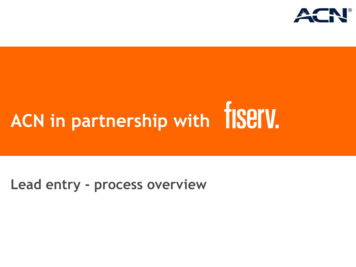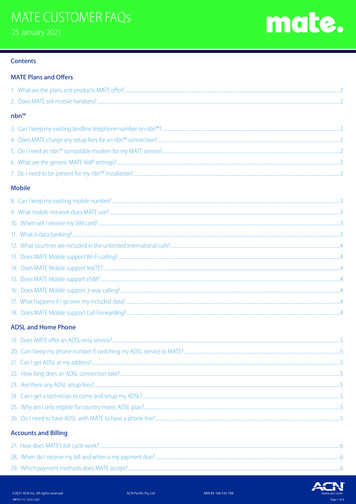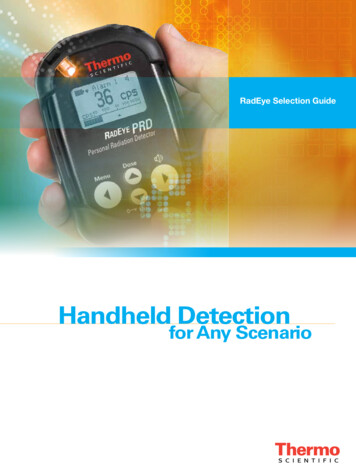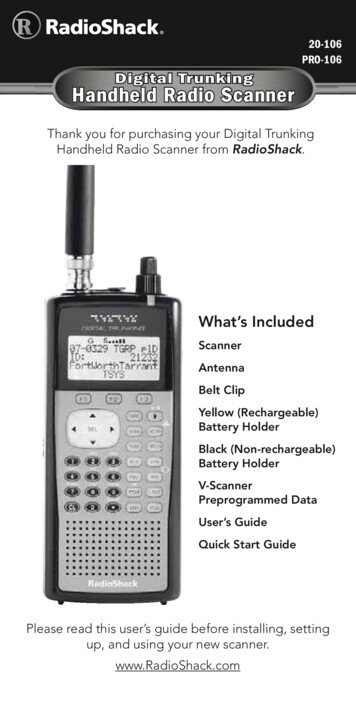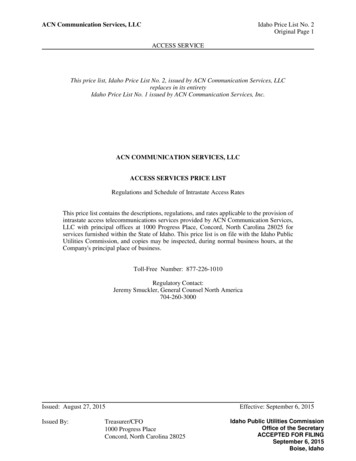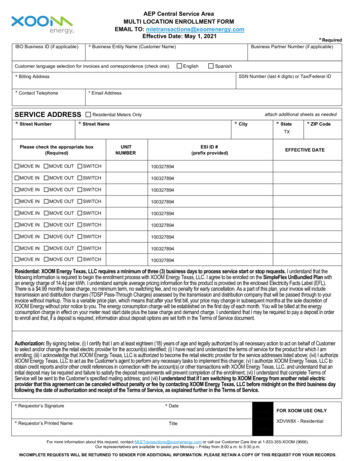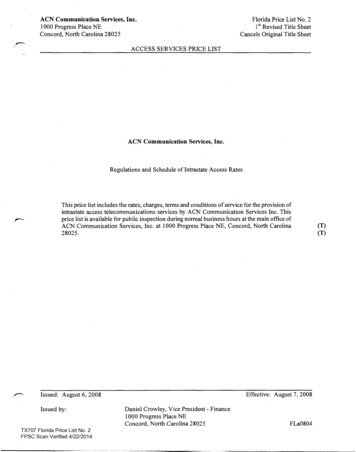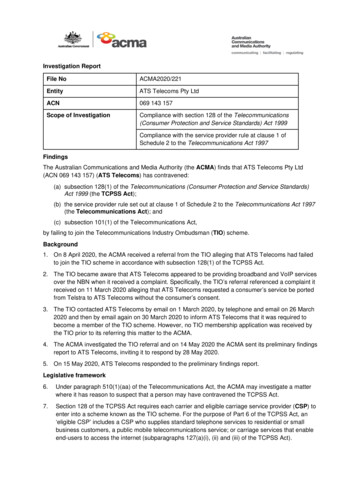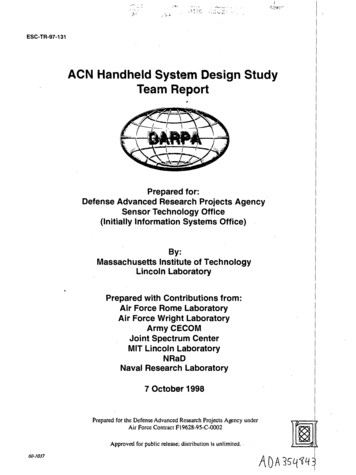
Transcription
/ '. : KESC-TR-97-131ACN Handheld System Design StudyTeam ReportPrepared for:Defense Advanced Research Projects AgencySensor Technology Office(Initially Information Systems Office)By:Massachusetts Institute of TechnologyLincoln LaboratoryPrepared with Contributions from:Air Force Rome LaboratoryAir Force Wright LaboratoryArmy CECOMJoint Spectrum CenterMIT Lincoln LaboratoryNRaDNaval Research Laboratory7 October 199860-1037Prepared for the Defense Advanced Research Projects Agency underAir Force Contract Fl 9628-95-C-0002y-w Approved for public release; distribution is unlimited.)* 'jfl IADA 3?
This report is based on studies performed at Lincoln Laboratory, a center forresearch operated by Massachusetts Institute of Technology. The work wassponsored by the Defense Advanced Research Projects Agency, ISO, under AirForce contract F19628-95-C-0002.This report may be reproduced to satisfy needs of U.S. Government agencies.The ESC Public Affairs Office has reviewed thisreport, and it is releasable to the NationalTechnical Information Service, where it will beavailable to the general public, including foreignnationals.This technical report has been reviewed and is approved for publication.FOR THE COMMANDER7.GaryfTnturigian ''Administrative Contracting OfficerContracted Support ManagementNon-Lincoln RecipientsPLEASE DO NOT RETURNPermission is given to destroy this documentwhen it is no longer needed.jjjirn ./i! üreu: 1.1:21.:-.a-A? :.tldi/j tci israwiA
ACN Handheld System Design StudyTeam ReportPrepared with Contributions from:Air Force Rome Laboratory(David Legare, Thomas Blake)Air Force Wright Laboratory(Richard Sterling)Army CECOM(Michael Gleason, Edmund Erskine)Joint Spectrum Center(Al Moored, Capt. Andy Glassock [USAF], Gil Duke)MIT Lincoln Laboratory(Steven Bernstein, Mark Gouker, Jeffrey Schodorf, David White)NRaD(James Zeidier)Naval Research Laboratory(George Edwards)Prepared for: Defense Advanced Research Projects AgencySensor Technology Office(Initially Information Systems Office)By:Massachusetts Institute of technologyLincoln Laboratory7 October 1998Approved for public release; distribution is unlimited., 'iIJ,
ACN Handheld System Design Study ReportExecutive SummaryIntroduction.A. MotivationB. ScenariosC. InterconnectivityIII. Desired ServicesA. Circuit-Oriented ("PCS-Like") ServicesB. Data-Oriented ("Internet-like") ServicesC. Tactical Broadcast ServiceD. Paging ServiceE. Integration of ServicesF. Support Services1. Mobility2. SecurityIV. System ArchitectureA. Communication ArchitectureB. Recommended Asymmetric ArchitectureC. Efficiency of utilization1. Downlink2. UplinkD. Approaches to Uplink Multiple Access1. A channelized uplink structure2. Uplink access controlE. Network Interface ConsiderationsF. Duplexing OptionsG. Examples of COTS and GOTS Similarities and ContrastsH. Transponder vs On-board Processing1. Transponder to terrestrial base station2. User-user transponderV. Link Performance FactorsA. Free-space link calculationsB. Path Loss Degradations1. Multipath Effects2. Shadow Fading3. Foliage Attenuation4. Ground Reflection Effect5. Height of the Handset AntennaC. EMID. Capacity1. Signal-to-noise ratio2. Spectral efficiency (bps/Hz) of multiple access waveformsE. Anti-Jamming PerformanceF. Low Probability of Detection (LPD) PerformanceG. Spread Spectrum Selection FactorsVI. Frequency Selection 25272728292931313536363738394041424243454648
A.B.C.VII.A.Technical FactorsAllocation FactorsConclusionsImplementationAntennas1. ACN Antenna Considerations2. Handset Antenna Considerations3. Antenna Polarization4. Other System Issues Impacting Antenna DesignB. Uplink Demodulation1. General considerations2. Digital Signal Processing approachesC. Handheld UnitsVIE. Applicability of Cellular, PCS and other COTS TechnologiesA. Cellular (850 MHz) and PCS (1.9 GHz) Systems1. General applicability2. General shortfalls3. AMPS and CDPD4. IS-136 (formerly IS-54) TDMA AMPS overlay5. GSM6. IS-95CDMA7. Emerging Commercial DevelopmentsB. Mobile Subscriber Satellite (MSS) Systems1. General applicability2. General shortfallsC. Small User Data Satcom SystemsD. PagingE. ISM Band Communication EquipmentF. Emerging COTS ConceptsIX. Applicability of GOTS TechnologiesA. GloMo1. Design infrastructure2. Untethered nodes3. Wireless networks4. End-to-end networking and security5. Mobile applications supportB. Handheld Multimedia Terminal (HMT)C. MEMSD. Ultra CommE. Software Reprogrammable RadiosF. SUOG. CONDORH. Soldier PhoneI. Other SystemsX. Summary of Conclusions and 38383848484848586li
I.Executive SummaryAfter the DARPA UAV Communication Node Study of 1995 was completed, threefollow-on studies addressing particularly challenging areas were initiated by DARPA ISO. Thisreport covers one of the three and addresses the challenge of providing new communicationservices to users with handheld radios via an Airborne Communication Node (ACN). The twoother studies addressed EMI and Antenna Issues and Communication Controller and SystemInterconnections.Concomitant with the ACN studies, the DARPA/ISO Warfighter's Internet (WI) studywas also taking place. Because of the close relationship between these programs, advantagecould be taken of results from each by the other. Indeed, in the fall of 1997 DARPA made therelationship between ACN and WI more explicit in order to ensure that the technologies anddesign would be integrated. Therefore, the reader will see strong similarities between theconclusions expressed in this report and those of the Warfighter's Internet study.The goals of this study were to:1. Define a realistic set of services that could and should be provided by a high altitude longendurance Airborne Communication Node (specifically the Global Hawk) to users withhandheld radio sets. (Because there is no set of "Requirements" per se reliance was placedon previous studies that described relevant scenarios as discussed below.).2. Provide a basis for the specification of ACN handheld services (this was delivered in June1997 in anticipation of a contract solicitation).3. Investigate the applicable means to provide these handheld services, including the potentialuse of COTS and/or GOTS technologies. This is a major theme that runs through the entirereport.4. Recommend a system architecture and design approach.An outline of the report and a summary of principal conclusions is given below.Section II (Introduction) gives the motivation, goals and context for the system.Scenarios are described in which a high altitude unmanned airborne platform such as the GlobalHawk equipped as a Airborne Communication Node (ACN) can provide useful services tohighly mobile forces with handheld communication devices. These forces require connectivityamong themselves and also to repositories of data that may reside in theater or even in CONUS.This introduces the concept of asymmetric services which is felt to be an importantcharacteristic.Section III (Desired Services) describes the desired services to be provided to thehandheld user. These services are divided into four types, however it is emphasized that theyreally should be implemented as a single integrated data transport architecture. The four servicecategories are:1. Circuit-oriented ("PCS-like") Services for voice and other streaming data.
2. Data-oriented ("Internet-like") Services that provide the typical interactive computercomputer services that are becoming more prevalent at all force levels3. Tactical Broadcast Service (a few Mbps) which can be composed of a subset of the GlobalBroadcast Service (GBS) stream plus data injected in-theater.4. Paging Service for low data rate messaging and alertsSection IV (System Architecture) discusses several architectural alternatives, andrecommends a "base station-centric" approach which includes on-board ACN signal processing.It is also recommended that the architecture be asymmetric, i.e., that downlink data rate shouldbe able to exceed that of the uplink to and from individual users. Recommendations for uplinkand downlink signal structures and access techniques are given. Comparisons are made to COTSsystems.Section V (Link Performance Factors) describes a number of technical factors that willenter into the design of the physical layer aspects of the system including propagation andjamming. The difficulty of predicting exact performance measures will be seen, thusemphasizing the need for adaptive signaling techniques.Section VI (Frequency Selection Factors) summarizes key technical issues in theselection of operating frequency. However, frequency allocation constraints are at least asimportant. A separate report prepared by the Joint Spectrum Center (JSC) addresses this. Oneconclusion is that the ACN handheld system will need to be frequency agile for worldwideutility.Section VII (Implementation) presents aspects of system implementation from ahardware point of view. Two particular aspects are discussed in some detail: antennas anduplink signal processing.Sections VIII and DC (Applicability of COTS and GOTS Technologies) discusses anumber of COTS and GOTS technologies that are potentially relevant and gives their shortfallsand applicability. A major conclusion is that there is no COTS or GOTS system that provides acomplete "plug and play" system solution. However, there are specific technologies andcomponents that are applicable and should be pursued.Section X (Summary of Conclusions and Recommendations) presents a summary ofconclusions and recommendations. Principal among them are: A multi-Mbps multimedia handheld communication service using the ACN is feasible ACN handheld services should be tightly integrated with mobile networking concepts such asthose explored in the Warfighter's Internet study An asymmetric architecture (lower rate uplink than downlink) is recommended Adaptive, flexible physical links integrated with upper level protocols and applications aredesirable There are numerous GOTS and COTS (or in development) subsystem, component andprotocol technologies that are applicable
I No COTS or GOTS system has been identified as a complete "plug and play" solution toproviding secure, flexible, efficient and scalable ACN interactive handheld services COTS does not meet minimal AJ and LPD requirements Cellular, PCS and MSS systems are limited by their symmetric circuit-switchedarchitecture (although data services are evolving) Wireless LANs do not provide asymmetric services with low rate uplinks The commercial market should continue to be trackedUseful near-term demonstrations of the ACN/HH concepts can be achieved with off-the-shelfcomponents, but will not have the capacity, efficiency, range, security and form-factor of afinal systemA flexible approach to the selection of operating frequency and bandwidth is necessaryDevelopment is required in the areas of detailed system design integration with Warfighter's Internet networking concepts detailed physical layer designs and protocols efficient uplink multi-channel multiple access techniques realization of on-board processor adaptive robust physical links ACN antenna concepts: shaping, sectoring, nulling low power handset components interfacing with legacy radio networksUseful near-term demonstrations of the ACN Handheld (ACN/HH) system concepts could beaccomplished using off-the-shelf components, but will not have the capacity, efficiency,range, security and form-factor of a final systemA separate report (prepared by the Joint Spectrum Center) addresses frequency allocationissues[JSC].,II,IiI
n.IntroductionThis introduction provides the motivation for performing this study and the goals that ithoped to achieve. The rest of the report is devoted to exploring the technical issues andpresenting the conclusions.A. MotivationAirborne platforms such as the Global Hawk provides a highly desirable platform for useas an Airborne Communication Node thanks to its ability to be launched and retrieved far fromits theater of operation, its high operating altitude, and long loiter time. It is particularly valuablefor early entry and clandestine operations when a significant communication infrastructure maynot be available or prudent to usePrevious studies, e.g., Extended Littoral Battlespace and Sea Dragon, have shown that inthese situations an ACN can provide important communication services to personnel with"handheld" communication equipment, i.e., equipment with the size and weight of cellularphones and having minimal orientation and positional restrictions. This would provide truecommunication-on-the move capability. As illustrated in Figure II-1 the communicationequipment, in addition to providing voice service, can be connected to portable computers orcapable personal digital assistants for enhanced digital communication services and applications.It is highly desirable that these services, e.g., voice and data, be provided with apparentsimultaneity to the user.50-100 WATTS0.5 - 3.0 watts "PCS-like" voice "Internet-like" data Tactical Broadcast Service PagingFigure II-l Handheld Services
It should also be noted that an airborne relay or network of relays is not planned to be theonly means of providing battlefield communication to mobile users. There will be a continuingneed for direct peer-peer communication, e.g., SINCGARS and other radios, tactical SATCOM,and almost certainly a growing use of commercial personal satellite communication. It is not theintent of this study to trade-off all of these modes against an airborne relay, but rather to developan approach for the most effective airborne relay system in itself which can then be rated incomparison.While the importance of handheld communication is clear, the most effective means toimplementing it has not been. A common suggestion that arises is the use of COTS cellular, orPCS technology, i.e., "why not fly a commercial base station?". While appealing at first look,this direct approach will be seen to have serious shortcomings in the context which will bedescribed later in this report. There are potential other COTS or GOTS technologies that willalso be examined. The COTS and GOTS issue should not be thought of completely "either-or".Indeed, there are service models, protocols, chipsets and other techniques that are extant in thecivilian and government worlds that can be directly applied to the handheld communicationsolution. Thus it is recognized that although commercial systems may not meet all militaryneeds, significant technology within these systems may be adapted to create a cost-effectivesolution that does.B. ScenariosIt is helpful to describe some scenarios in which handheld communication via an ACNwould provide a major pay-off. In particular, contingency and early entry assaults as describedbelow and in [WI] are representative examples.Contingency operations as depicted in Figure II-2 are likely to be comprised of smallunits, rapidly deployed, and at long range from their support services. Tactics involving smallunit operations (SUO) may be used where teams of 10 to 20 soldiers are deeply deployed todetermine enemy movements and then call in massive indirect fire rather than engaging theenemy directly. Special Operations Forces (SOF) operate in a similar manner, althoughtraditionally they have only their own resources for support, and rely on stealth and surprise forsuccess. The SUO depends on long-range communications (BLOS) for success. However,heavy communications infrastructure is inconsistent with their light armament and deploymentmethods. The use of simple line-of-sight radios to reach an airborne communication node whichin turn is able to relay messages from user to user as well as from Theater and/or CONUScommand and support services is an effective way to provide the connectivity these forces need.Through this node can flow needed command and control traffic, ISR products, and requests formedical, logistic, and fire support services. The majority of this traffic is (bursty) computer data,but it also includes (continuous rate) voice and video.Amphibious assault is another scenario that can benefit from an airborne communicationsnetwork, and is typical of early entry situations with limited support infrastructure. Futureamphibious assaults will likely be carried out with fleet resources over the horizon from thebeachhead or landing zone in order to protect ships from cruise missiles. Troops arriving from
landing craft and from helicopters will not have the ability to bring with them heavycommunications infrastructure.Even in more conventional force deployments, there will be situations where some forceshave lost line-of-sight connectivity with the rest of the forces, due either to rapid maneuvers or togeographical factors (such as intervening mountains). The airborne network can provide theneeded connectivity in this case as well.#"DISNICONUSC2ISRLogistic MedicalIDISNSTEPITHEATERC2ISRLogisticsMedicalFire SupiftI ,V. 1COMSEBNBDEDIVFigure II-2 Representative ScenarioC. InterconnectivityFigure II-3 shows the interconnectivity that is implied for the ACN handheld unit.Primarily, of course the handheld unit will connect with the ACN. In turn, the ACN will be ableto interconnect an ACN handheld user with:
MILSTAR,DSCS,GBS,Commercia\ (Crosslinks)AlternateHandheldModesRemote and TheaterData BasesFigure II-3 Connectivityother ACN handheld units connected to the same airborne platform. These units may beconnected point-to-point; or as fully connected nets similar to combat net radio; or as apacket data network with multicast features.other ACN handheld units that are interconnected to other airborne platforms via crosslinks.legacy radios, e.g., SINCGARS, and HAVEQUICKtheater and global communication infrastructure, e.g., MSE and DISN, as circuit or packetdata internetworks.The connection to the theater and global infrastructure is important to emphasize, for it isbelieved that the handheld users will rely on this for timely access to large amounts of data thatcan either be "pulled" or "pushed" from theater or remote servers. For example, it is expectedthat the Global Broadcast System satellite downlink (operating at a rate of over 23 Mbps) will bereceived at a theater entry node, filtered then mixed with theater-generated traffic andrebroadcast (at a lower rate) to handheld users. Other examples include user access to theaterdata bases, e.g., weather, situational awareness, and email.(Also shown are a number of alternate modes that may be desirable for the handset tosupport. These include: terrestrial commercial infrastructure if available; commercial mobilesatellite subscriber (MSS) satellite services; connectivity with DoD deployed cellular-like basestations; and a direct peer-peer mode as is under development by the Small Unit Operations(SUO) program. The inclusion of these modes in a handset raises design issues similar to those
faced by multi-mode cellular handset manufacturers. While inclusion of these alternate modes inthe handheld radio may be desirable, they do not have to be supported directly by the ACN itselfand therefore are not considered further in the discussion to follow.)
DQLDesired ServicesThere are four basic services that the ACN should provide and these are described below.However, these services should in fact be considered as four facets of a single integrated ACNdata service for handheld users.To go further, it is recommended that all of these services be available to the user withapparent simultaneity. The architecture that is recommended will accomplish this.A. Circuit-Oriented ("PCS-Like") ServicesCircuit-oriented or "PCS-like" services refer to the services that are normally associatedwith cellular telephone, the newer PCS systems, and the emerging MSS (mobile satellitesystems).
1. ACN Antenna Considerations 50 2. Handset Antenna Considerations 63 3. Antenna Polarization 65 4. Other System Issues Impacting Antenna Design 66 B. Uplink Demodulation 67 1. General considerations 67 2. Digital Signal Processing approaches 68 C. Handheld Units 71 VIE. Appl
